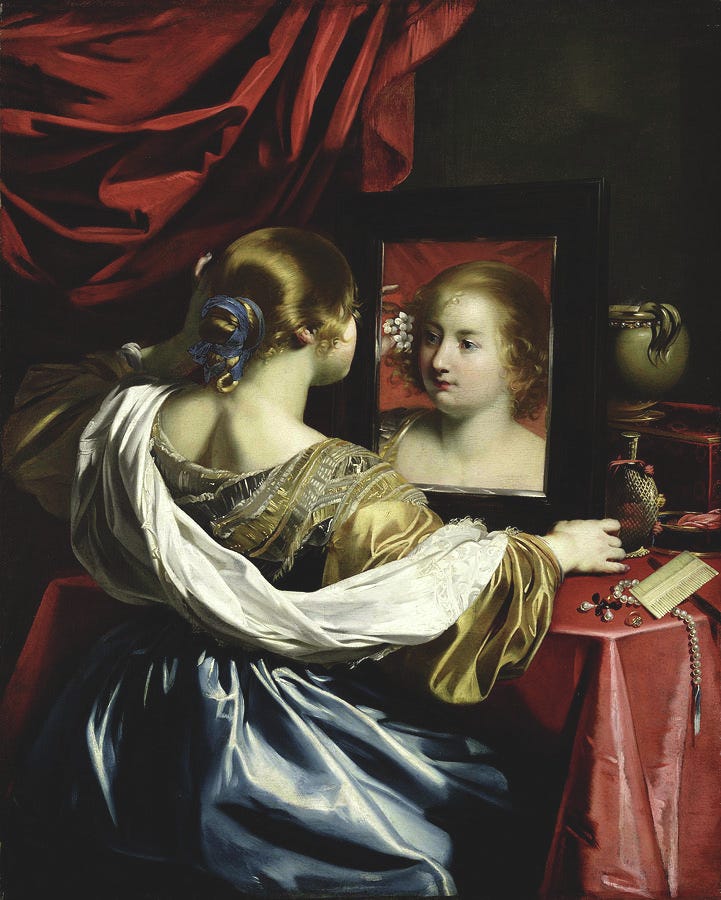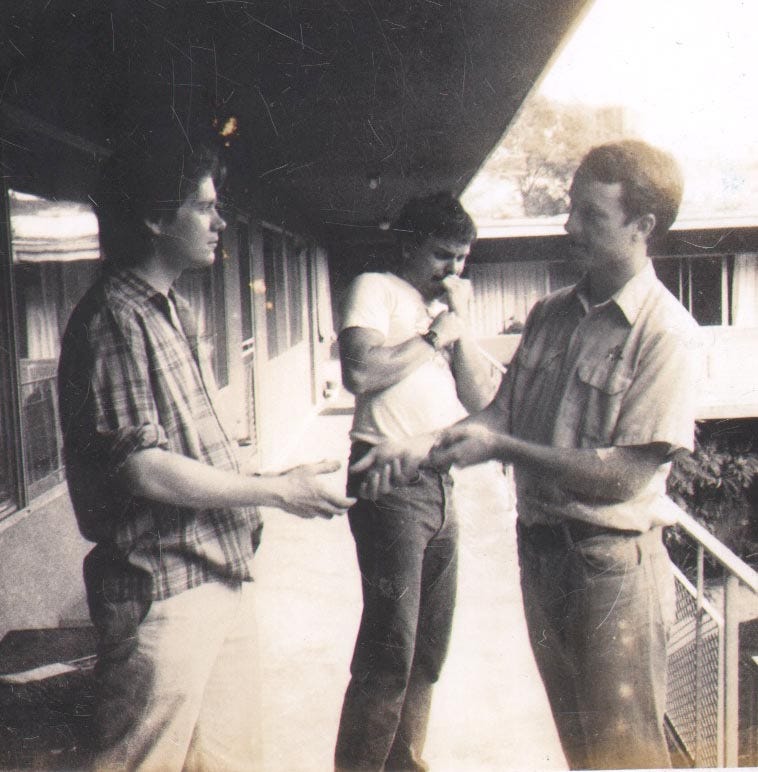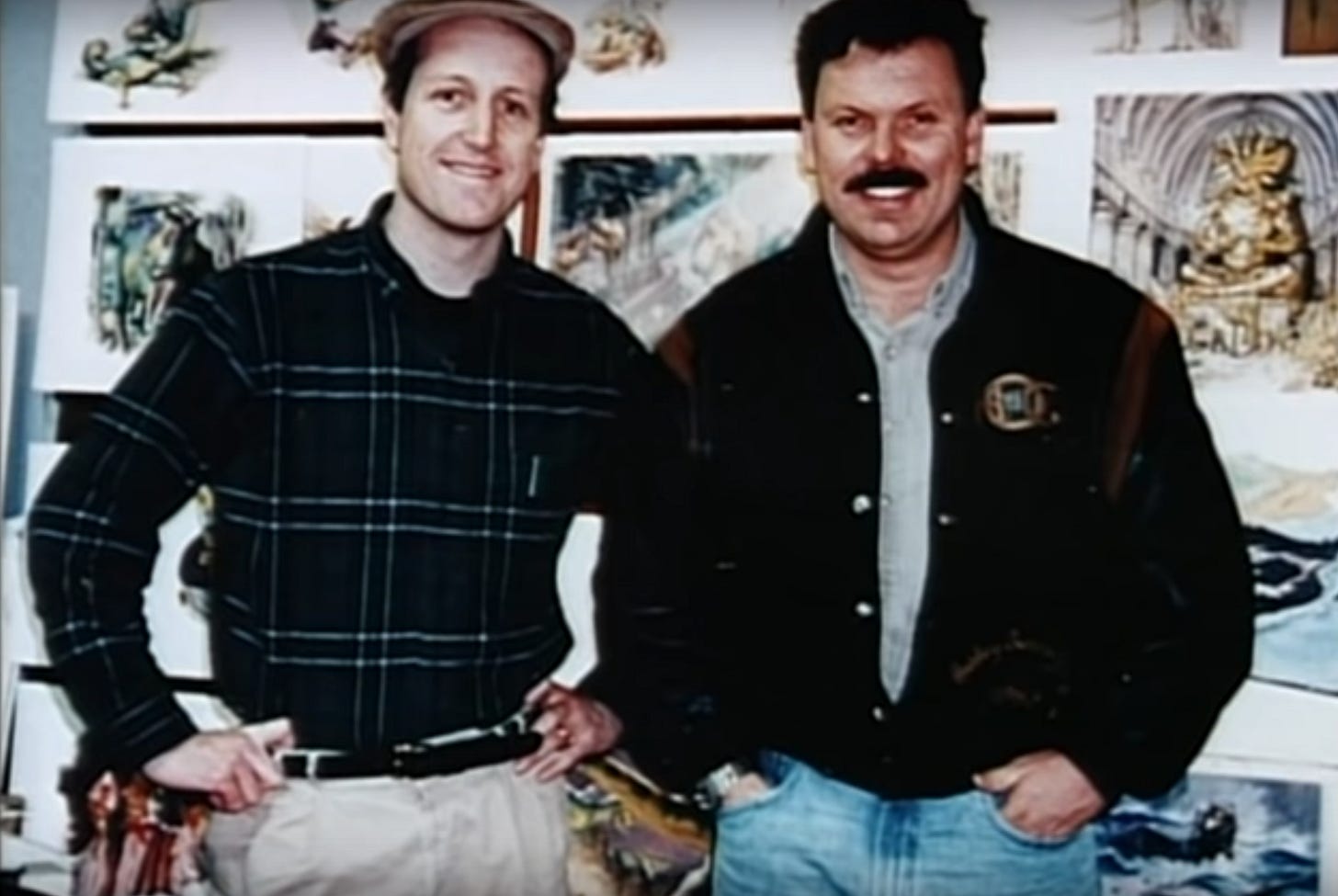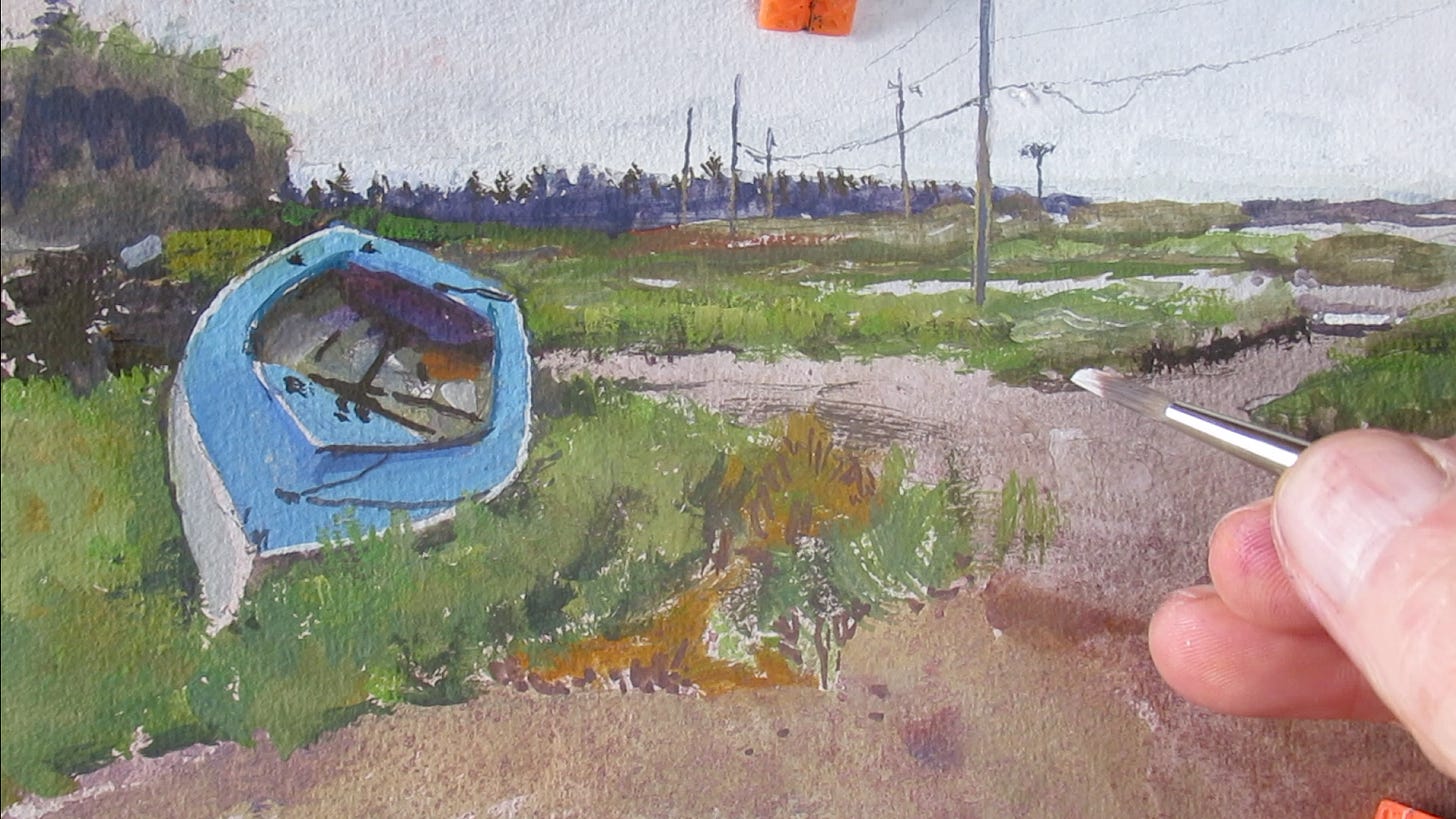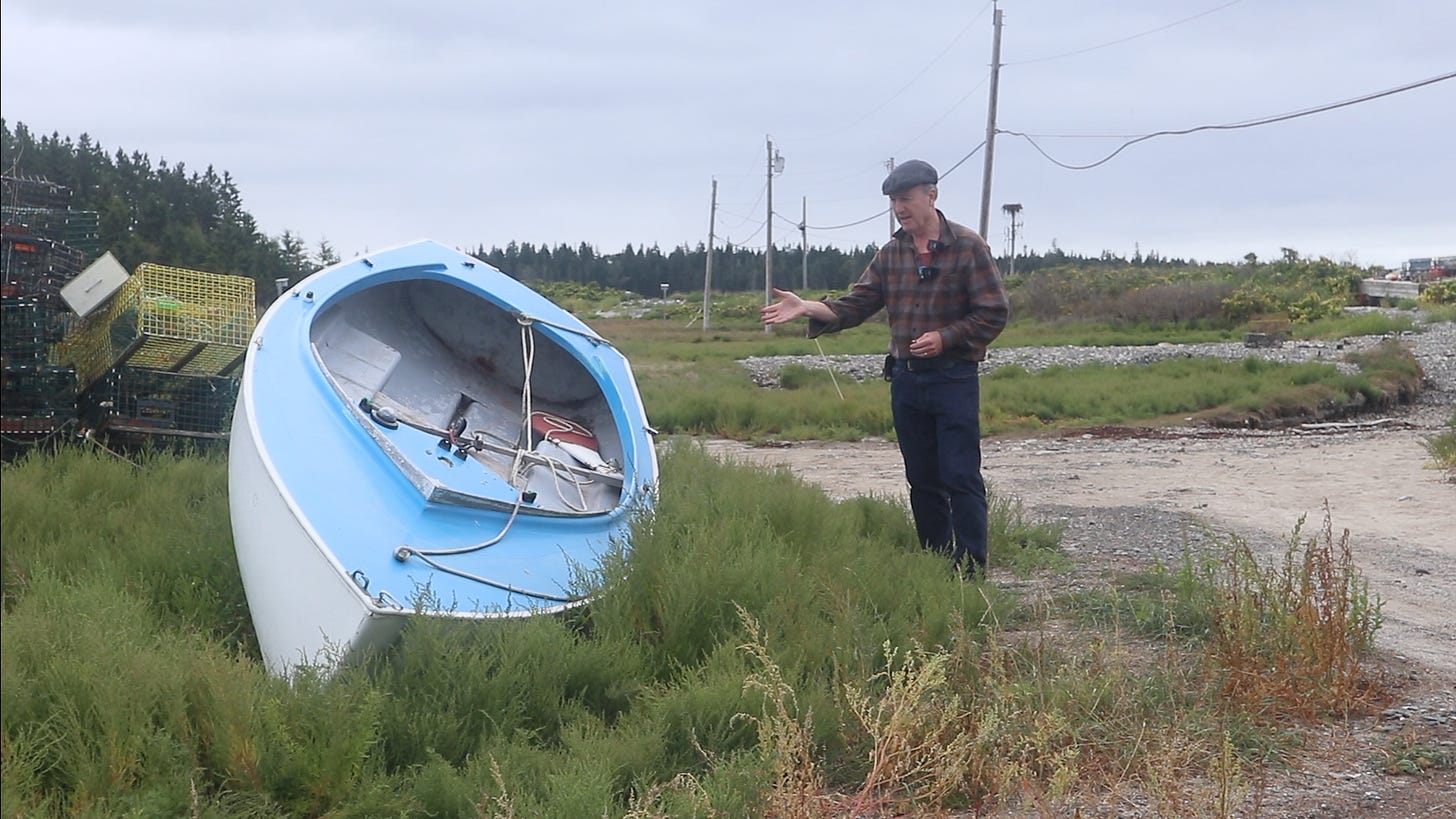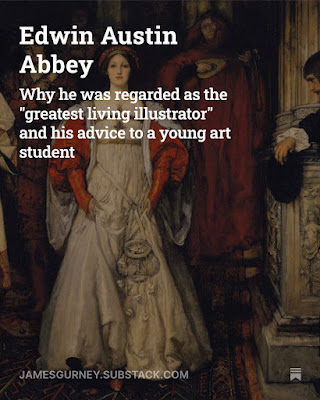Monday, October 13, 2025
Painting the Pre-Electric Night
Friday, September 26, 2025
Four Paintings to Be Auctioned on November 4
At the November 4 Illustration Art Auction at Heritage Auctions, four of my paintings will be offered for sale.
This is the comprehensive sketch for the cover of the 1983 science fiction novel by William Greenleaf, published by Berkeley/Ace.
This was my first paperback cover as a freelance illustrator. After finishing the background paintings for Ralph Bakshi's Fire and Ice, I turned down an offer from Disney Animation and decided to take the plunge as a freelance illustrator, painting paperback covers and sending the paintings by overnight mail to New York.
Story: A space shuttle stranded on a hellish planet leaves its crew of five in a dangerous predicament.
In these works you can see my fascination with British and French academic painters, such as Lawrence Alma Tadema, Ludwig Deutsch, William Logsdail, and Jean-Leon Gerome. I was living in Los Angeles at the time, overnighting the comps to the art directors for approval before proceeding with the finished art.
Companions, oil on board, 20 x 16 inches (50.8 x 40.6 cm)

Much to my amusement, it also appeared as a meme. It was widely circulated as a viral meme with a tagline "That wasn't a microdose."
Link to the Heritage Auction website
Living With Mammoths in Dinotopia
The partnership with mammoths began modestly, with villagers gathering the tufts of wool that the gentle giants shed in spring.
Later, when orphaned calves were taken in and successfully reared, the community recognized their potential as companions and helpers. This gave rise to organized “mammoth nurseries,” where young calves and human children grew up alongside one another, playing games together—games like Tusk Ring, Wool Tag, Trunk Lift, Shadow Step, Splash Parade, Stomp and Sing, and Bundle Push.
If you're curious about how any of those games work, just ask me in the comments, and I'll explain, based on Arthur Denison's journals.
Art from Dinotopia: Journey to Chandara.
.
Tuesday, September 16, 2025
Marty Owings Reviews Books on Sketching
Marty Owings: "If you read the book it will unlock many secrets to being a better sketcher."
Sunday, September 14, 2025
First Contact with Mirrors
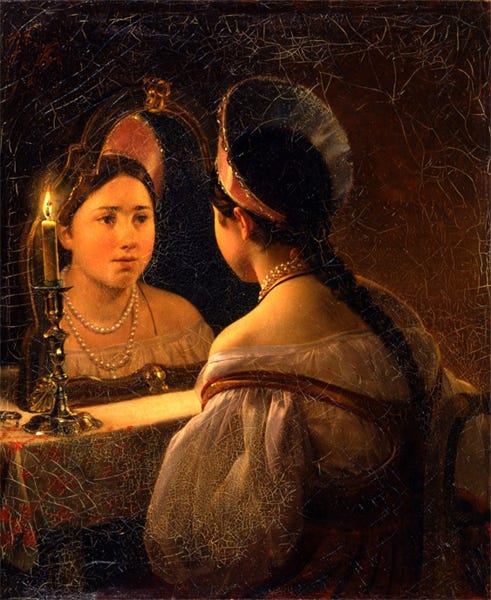
Svetlana at fortune-telling by K.Bryullov, 1836
Mirrors have a powerful effect on people who have only seen their reflection in stll water. Individuals recognize themselves immediately, but that's just the beginning.
Anthropologist Edmund Carpenter presented mirrors to indigenous people in New Guinea, and noted that they were intensely curious about them, and they underwent a series of shocks. These same shocks occur in other cultures, too:
Recognition shock. Realizing it’s your face. Followed by testing and play. This is a human universal, and holds true for several non-human animals, including apes, dolphins, elephants (and maybe mice, manta rays, and perhaps even ants.)
Grooming. Using the mirror to apply makeup, face painting. Societies that get universal access to mirrors typically go through a phase of obsession with personal adornment and identity. If mirrors are more rare they become objects of high status and trade value.
Moral Framing. Sometimes an elder will use the mirror to drive home an ethical or moral point. Socrates told young people to look often into a mirror, and “if they were handsome, they should not disgrace their beauty by evil conduct, and if they were ugly, they should counterbalance the defect by their accomplishments.” (Lives of Eminent Philosophers II.33)
Spiritual Uses. Some Greeks participated in catoptromancy, a kind of divination using mirrors, which was later condemned by the church.
Normalization. This is the mode of interaction we’re familiar with, where the mirror is just an ordinary tool and part of our personal grooming routine.
In Oh, What a Blow That Phantom Gave Me! (1972), Edmund Carpenter recalls giving mirrors to people in Papua New Guinea’s Sepik region:
“The visual shock was overwhelming. After the first startled recognition, came testing. They grimaced, danced, made faces. They examined their teeth, painted themselves, laughed or cried. Some hid the mirrors, as if they were too dangerous, others traded them as treasures. … The mirror provided an image of the self, detached and external, and this provoked not vanity so much as metaphysical unease.” (Carpenter 1972, pp. 118–120)
What looked to early European observers like narcissism was in fact a deeper confrontation or encounter with a person’s identity. The mirror was a shock because it externalized the self.
A mirror gives us an image without substance. It is never a neutral object to someone encountering it for the first time. It can be a goad to virtue, a diagnostic of fate, or a glimpse of another order of reality.
Saturday, August 16, 2025
Advice I'd Give My 24-Year-Old Self
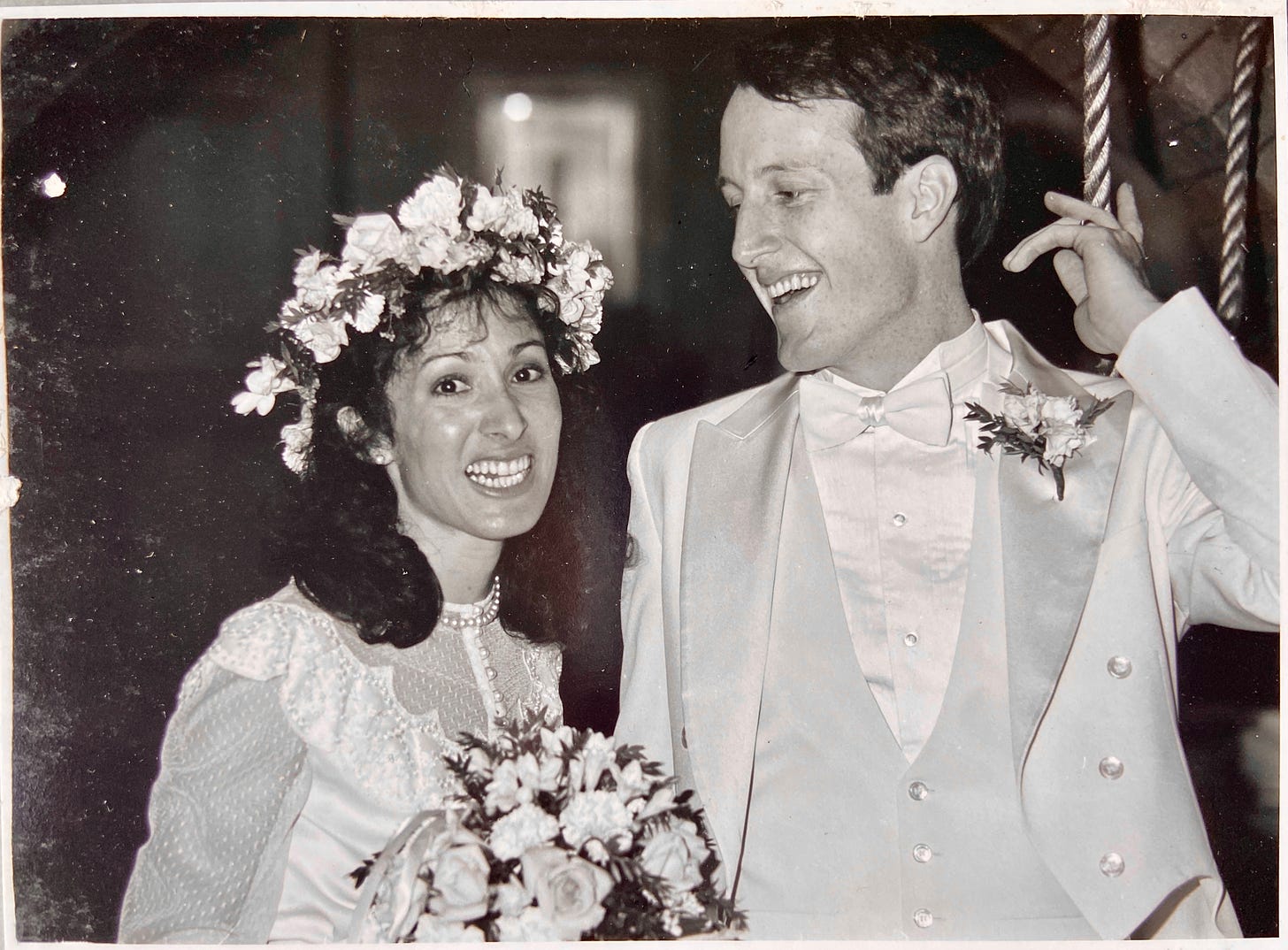
Jeanette and me, age 24
The part of my recent YouTube video that attracted the most interest was my answer to Andrew’s question about what advice I'd give myself when I was 24.
But honestly, I didn’t need that advice back then—I was already on a solid path. I had worked as a background painter for Ralph Bakshi’s renegade animation studio, published my first book, and was about to turn down a job offer from Disney.
I was getting married, moving east, and starting a freelance illustration career. I was still essentially broke, but I was learning a lot, and I would have said to my older self, "Yeah, yeah, I'm already doing what you're saying."
Age 20, with Paul Chadwick and Tom Kinkade, posing for reference
Age 36, working on Dinotopia: The World Beneath
What would have caught my attention at 24 was a glimpse into how dramatically the world would change for artists over the next 40 years because of digital technology. Read the rest at Substack.
Monday, August 11, 2025
What I Learned from Painting this Boat
Monday, August 4, 2025
Which Colors Are Primaries?
Full story on Substack today.
Wednesday, July 30, 2025
I'm Editing a Video, and I'd Love to Include Some of Your Questions
I’m editing a YouTube video, where I paint this little plein-air study of a stranded sailboat:
It’s painted in gouache over a casein priming.
If you have a quick question about the process, you can ask it here in the comments. Or, even better, you can ask a voice question on this Speakpipe link.
Tuesday, July 29, 2025
Painting from Imagination
Thursday, July 10, 2025
'You should be sketching always, always'
Abbey wrote to an art student: "You should be sketching always, always. Draw anything. Draw the dishes on the table while you are waiting for your breakfast. Draw the people in the station while you are waiting for your train. Look at everything. It is all part of your world. You are going to be one of a profession to which everything on this earth means something." More on Substack
Monday, July 7, 2025
Is the Computer a "Bicycle for the Mind?"
Steve Jobs wanted the personal computer to be like a “bicycle for the mind.” Has it worked out that way for you?
More on my Substack.
Thursday, June 26, 2025
Cesare Tallone's Sight-Size Paintings
Tallone's artistic legacy was further cemented through his teaching positions at the Carrara Academy in Bergamo and later at the Brera Academy in Milan, where he passed away on June 21, 1919.
Sunday, June 15, 2025
Reflecting on My Dad
I was never sure what my dad did for a living, because I never got to visit his workplace. He was in mechanical engineering jobs that were either highly technical or top secret.
Once he mentioned that he was in “high vacuum technology.” To my grade-school imagination, that meant he drove around in a giant Hoover vacuum cleaner.Dad read widely, and he must have had a lot of deep thoughts. But he kept those them mostly locked up inside his head. Maybe I didn’t have enough wit to ask him the right questions to unlock those thoughts.

But also, American dads were probably more remote to their kids in those days than they are now.
He’s been gone now for almost 25 years, and I still think fondly about him. When I clear my throat, I realize I sound exactly like him. I can’t help imagining him riding around on that giant vacuum cleaner.
Wednesday, June 11, 2025
Painting a Monkey Skull
The Akin Free Library in Pawling, New York is like a time machine that takes you back to a different way of organizing and presenting knowledge about nature.
It's worth a visit, but it's only open Saturdays and Sundays 1:00-4:00d, May - October. Ask to make sure, but it's usually OK to bring stools neat sketch supplies, such as pencil or watercolors.
LWatch this painting bbeing made Here's a link to video
Friday, May 23, 2025
Remote Control Models
This is high-school-age me with a Hobie Hawk, a two-servo glider with elliptical dihedral. The kit was invented by Hobart Alter, same guy who created the Hobie catamaran.
I also designed and built a flying-wing glider. No tail assembly, just wings. The airfoil changed from a lifting airfoil at the root of the wing to a reverse airfoil at the tips of the swept-back wings. That held the lifting surface at a good angle of incidence. The rudder and elevator controls went through a mechanical mixer on the servo brick that activated the elevons.
This is the kind of thing I thought about in high school during my free time. I’d be standing on the ground, with my imagination soaring 300 feet above me, dreaming what it would feel like to be a red-tail hawk.
My dad was a mechanical engineer, and he would occasionally give me pointers on tools and build techniques.
I also made a tugboat out of pine planks stacked and glued, carved to a hull shape, and fiberglassed over. This one took me all summer to build. The motor was powered by a motorcycle battery. It took some perilous voyages across the chop of the Palo Alto duck pond. It had lights inside and looked pretty realistic at night.
I didn’t know this at the time, but my fascination with scratch-built, remote-controlled airplanes and boats set me up for building the fantasy world of Dinotopia. Making these models helped project my imagination into places. Working for months on a single project gave me an instinct for delayed gratification.
There was real peril for the gliders. I once handed the stick to another pilot, inviting him to try flying the wing inverted, and he snapped off both wings by half-looping out of it. Poor guy, he felt so bad. But no problem. I went home, fixed it, and flew on.
My dad built his own glider and put a strand of piano wire in the leading edge of the wing “in case of a midair collision.” That day arrived: CRASH! Down went the other guy's plane. But Dad's plane survived. He kind of grinned, but didn't tell the other guy about the piano wire.
Saturday, May 17, 2025
Flower Pastels of Laura Coombs Hills
On Substack today, a look at the Life and work of Laura Coombs Hills.
Wikipedia Laura Coombs Hills
Tuesday, May 13, 2025
Dark Mirrors
For centuries artist have used darkened mirrors and smoked lenses to help them view a real landscape in simplified tonal values. More on Substack
Friday, May 2, 2025
You're Not Allowed To Imagine Thaat
What are the implications of an AI model that refuses to cooperate? What happens when it tells me that I’m not supposed to imagine something? What if it becomes illegal to imagine something without using a safe-certified AI? More on Substack







